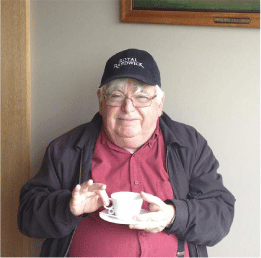Obituary: Peter William Robertson (7 July 1945–6 July 2022)
William D. Rawlinson , Mark J. Ferson and Peter C. TaylorMicrobiology Australia 44(1) 64-64 https://doi.org/10.1071/MA23018
Published: 10 March 2023
© 2023 The Author(s) (or their employer(s)). Published by CSIRO Publishing on behalf of the ASM. This is an open access article distributed under the Creative Commons Attribution-NonCommercial-NoDerivatives 4.0 International License (CC BY-NC-ND)

|
In July 2022, 1 day before his 77th birthday, Associate Professor Peter William Robertson sadly passed away. Peter was a world leader in diagnosis using serology, particularly in the areas of human immunodeficiency virus (HIV) and other blood-borne virus diseases. Peter worked on improved diagnosis for common diseases including respiratory viruses at a time when before we had heard of SARS-CoV-2 and were more concerned with influenza. He undertook applied research into serological diagnostics, and development of national quality assurance programs that to this day are used by diagnostic laboratories around Australia. Peter’s particular expertise was in trying to bring old and new technology to new clinical problems. Peter was appointed Principal Scientist as head of Area Serology, a Conjoint Associate Professor at UNSW, and was a postgraduate student supervisor and lecturer at UNSW. Trainee scientists and pathologists would regularly spend time in Peter’s laboratory, and many of them would participate in research projects leading to peer-reviewed publications.
His early work was in Eastpath, subsequently, the South Eastern Area Laboratory Service (SEALS), and most recently the Area Serology Laboratory of SAViD, New South Wales Health Pathology Randwick. Peter was appointed to the Department of Microbiology, The Prince of Wales Hospital, in 1970 to develop and enhance serological diagnosis of infectious diseases. He had a much broader role, and was instrumental in positioning this reference laboratory at the centre of diagnostics for blood-borne viruses, infections of pregnant women, EBV characterisation, as well as much of diagnostic serology. He was an early adopter of new technology. He undertook studies in techniques no longer used routinely, such as column fractionation of immunoglobulin classes to establish IgM and IgA assays to identify primary infections in utero and of IgA assays to be able to demonstrate active adult pertussis the cause of whooping cough in infants. Peter’s expertise in the diagnosis of congenital rubella and toxoplasmosis was sought by clinicians and courts alike, and his work on diagnostic serology of measles, pertussis and meningococcal disease, among others, were highly valued by the public health community in New South Wales and more broadly.
The demand for widespread testing for blood-borne infections increased with new tests for HIV but also with the increasing array of hepatitis viruses. Blood-borne virus testing is fundamental to the public health programs to reduce infection with hepatitis B and C, as well as HIV. Peter’s work personally in developing these studies, for example on HIV (published in the Medical Journal of Australia in 1985) at the time when HIV (then called HTLV-3) diagnostics was in its infancy, has saved many lives. Peter has been a mentor to the majority of Australians working in serology in the late 20th century in one way or another. He founded the first serology quality assurance program for the RCPA in 1973 when this was sent out from Prince of Wales Hospital as part of the national microbiology survey.
Peter’s work in HIV included working closely with government, national bodies such as the NRL, and in the Area Serology Laboratory at Randwick. He continuously improved assays for HIV and used these assays during the 1980s to test at risk individuals and produce improved confirmatory assays (such as Western Blot in 1992) for serological diagnosis of HIV. His work on congenital infections, including congenital cytomegalovirus (CMV) and rubella, started in the 1970s on the back of his research published in 1969, on anti-Rh antibody testing. As principal scientist of the Area Serology Laboratory, he continued to research and publish in translation of better ways of diagnosing congenital CMV, and congenital toxoplasmosis, through collaborations around Australia.
Peter’s education was initially a BSc in microbiology in 1967, followed by a MSc in 1968 and a PhD 5 years later under Prof. Kevin Marshall, on the immune responses in intestinal lymphoid tissue. He initially started as a training medical technician at the Kanematsu Institute at Sydney Hospital in 1963, 2 years later becoming a science student and then moving to the New South Wales blood transfusion service where his passion for serology and diagnosis led him to his later position as principal scientist of what was then SEALS. He was honoured with admission as a founding fellow of the Faculty of Science at the Royal College of Pathologists of Australasia in 2012 (FFSc), and received commendations from the New South Wales Government with the Premiers Public Sector Award Commendation in 2010, and a Meritorious Service Medallion in 2012. He became production manager of a Therapeutic Goods Administration-licenced donor screening laboratory in the early 2000s, and continued to supervise students in medicine and science, as well as being an invited speaker at meetings around the country.
Peter married Susan van Gelder in 1967, and together they raised three children, Michael, Jennifer and John. He is very much missed by them, and by his colleagues. He was above all a man of honesty, passion, vision and belief. The world is smaller for his absence, but we are all slightly greater for having known him. Requiescet in pace.


